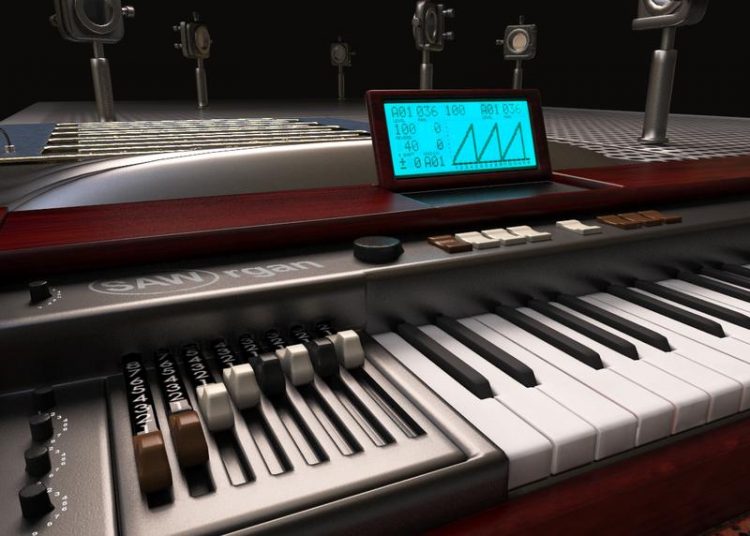Shaping a more than perfect wave

Artist impression of a nanomechanical synthesizer © Christoph Hohmann/NIM
In their recent publication in “Nature Nanotechnology”, NIM graduate Florian Schülein and his supervisor NIM-Professor Hubert Krenner at the chair of Experimental Physics I (Prof. Achim Wixforth) demonstrate, that nanoscale sound waves with different frequencies can be superimposed on a chip to program and synthesize a well-defined nanomechanical wave. They use these shaped waves for fast and deliberate nanomechanical control of quantum effects in a semiconductor artificial atom.
Back in the early 19th century, the French scientist Joseph Fourier showed that any wave can be composed of a well-defined combination of a fundamental tone and a series of overtones. This fundamental principle is used in innumerable everyday life consumer products. For example, music synthesizers like the famous ‘Hammond Organ’ generate sound using Fourier synthesis.
For MP3 encoding, the opposite procedure, Fourier analysis, is key to reach ultimate data compression. In their experiments, the team of physicists applies the fundamental principle of Fourier synthesis to generate nanomechanical sound waves of precisely defined shapes on a chip. Their approach is based on surface acoustic waves, nanoscale earthquakes, a technique Achim Wixforth and the Augsburg group are renown experts in.
“To gain full control of the shape of the nanoquake we had to develop an advanced design for the electrodes which generate the sound wave”, notes Florian Schülein. The team solved this problem by developing new electrode geometries. With these, they were able to excite not only a fundamental sine wave but also a large number of overtones at highest intensities at the same time. His supervisor, Hubert Krenner adds:
“These advanced transducers were key since all of a sudden we could really superimpose the different frequencies with unprecedented efficiency. When we combined the different frequencies with well-defined portions, and thus turned a simple sine wave into a square or triangular wave or even a short ‘kick’.”
To prove that they really generated the desired nano-wave, the researchers required fast nanoscopic ‘pressure sensors’. They used single quantum dots fabricated at IFW Dresden for this purpose. These quantum dots are nanoscopic islands which emit light in sharp spectral lines. “The emission wavelength of these artificial atoms delicately depends on the local deformation of the material,” Achim Wixforth explains.
Hence, using this opto-mechanical coupling, the nanomechanical wave was converted into an optical signal. Florian Schülein proudly adds: “Using our extremely fast stroboscope it was fantastic to see how the quantum dot spectral emission lines exactly move the way I programmed the wave!”
The Augsburg group is renowned for their pioneering work and application of surface acoustic waves. They apply these ‘nanoquakes’ to various types of nanosystems ranging from biophysical systems over microfluidics to fundamental physical effects such as the Quantum Hall Effect. All these experiments have attracted large attention worldwide and built the outstanding reputation of their research using their nanoquakes on a chip.
Based on this new breakthrough in the field of nanomechanics, researcher expect that quantum systems can be controlled in the best sense of the word quantum-mechanically using shaped and well behaved nanoquakes.
This work was supported by the Deutsche Forschungsgemeinschaft (DFG) via the Emmy Noether Programme (KR 3790/2-1), the Cluster of Excellence Nanosystems Initiative Munich (NIM), and Sonderforschungsbereich SFB 631, by BMBF via project QuaHL-Rep and by the European Union via Seventh Framework Programme project HANAS.
Reference:
Florian J. R. Schülein, Eugenio Zallo, Paola Atkinson, Oliver G. Schmidt, Rinaldo Trotta, Armando Rastelli, Achim Wixforth, and Hubert J. Krenner
Fourier synthesis of radiofrequency nanomechanical pulses with different shapes
Nature Nanotechnology – advanced online publication; doi:10.1038/nnano.2015.72 (2015)
Link: http://dx.doi.org/10.1038/nnano.2015.72
Contact:
Prof. Hubert Krenner – hubert.krenner@physik.uni-augsburg.de
Prof. Achim Wixforth – achim.wixforth@physik.uni-augsburg.de
Dr. Florian Schülein – florian.schuelein@physik.uni-augsburg.de
Lehrstuhl für Experimentalphysik I
Universität Augsburg
Universitätsstraße 1
86159 Augsburg
Telefon +49(0)821-598-3308
http://www.physik.uni-augsburg.de/lehrstuehle/exp1/
Media Contact
All latest news from the category: Physics and Astronomy
This area deals with the fundamental laws and building blocks of nature and how they interact, the properties and the behavior of matter, and research into space and time and their structures.
innovations-report provides in-depth reports and articles on subjects such as astrophysics, laser technologies, nuclear, quantum, particle and solid-state physics, nanotechnologies, planetary research and findings (Mars, Venus) and developments related to the Hubble Telescope.
Newest articles

Durable, Efficient, Sustainable: The Rise of Cerium Oxide Thermal Switches
Groundbreaking cerium oxide-based thermal switches achieve remarkable performance, transforming heat flow control with sustainable and efficient technology. Cerium Oxide-Based Thermal Switches Revolutionize Heat Flow Control Thermal switches, which electrically control…

How Industrial Robots are Reducing Emissions in Global Manufacturing
A new study explores the intersection of industrial automation and environmental sustainability, focusing on the role of industrial robots in reducing the carbon intensity of manufacturing exports. The research demonstrates…

Patients Can Heal Through Precise, Personalized Bioceramic Grafts
A recent review is transforming the landscape of craniomaxillofacial bone regeneration with the introduction of personalized bioceramic grafts. This pioneering research explores the fabrication and clinical potential of synthetic grafts…



